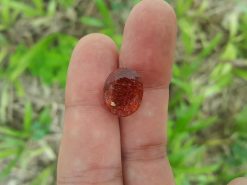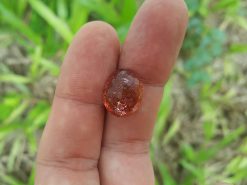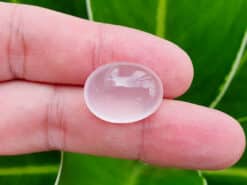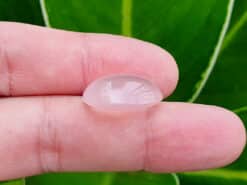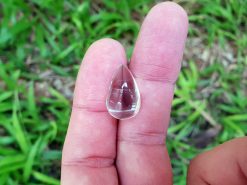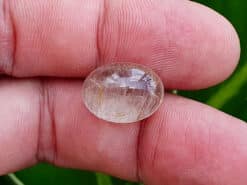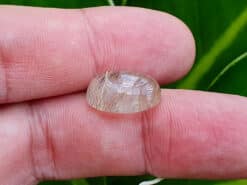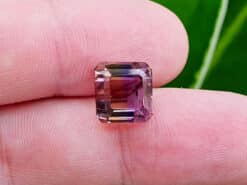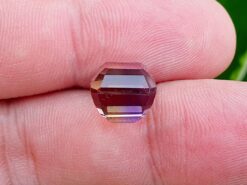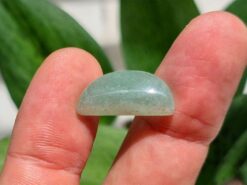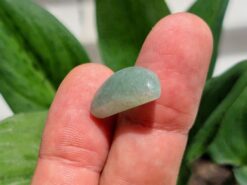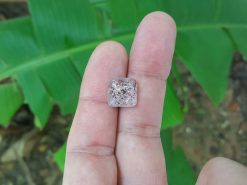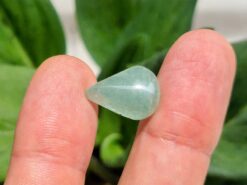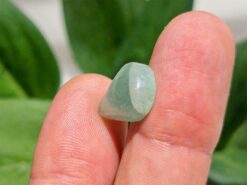Inclusions in quartz
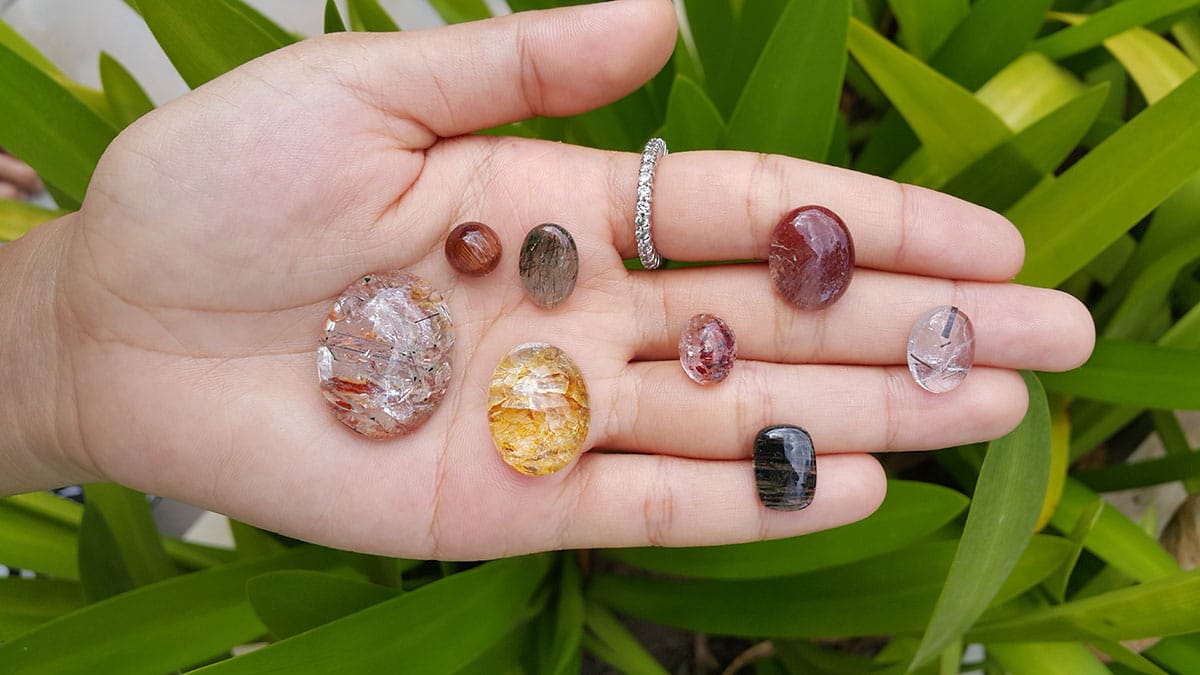
Buy natural quartz in our shop
Natural inclusions in quartz
Quartz belongs to the trigonal crystal system. The ideal crystal shape is a six-sided prism terminating with six-sided pyramids at each end. In nature, quartz crystals are often twinned, with twin right-handed and left-handed crystals, distorted, or so intergrown with adjacent crystals of this mineral or other minerals that they only show part of this shape, or lack obvious crystal faces altogether and appear massive.
Well-formed crystals typically grow in a bed that allows ample room to develop into a void, and usually the crystals are attached at the other end to a matrix, with only one termination pyramid present. However, doubly terminated crystals can form when they grow freely, such as within gypsum. A geode is one notable example of a cavity that can be lined with a bed of inward-pointing crystals.
Crystal growth and variations
When quartz develops freely, the process allows the crystal to exhibit well-defined prismatic shapes. Over time, slight fluctuations in the growth environment, such as temperature and chemical composition, can lead to fascinating zones of color, clarity, or inclusions trapped inside the crystal. These variations often become visible when the stone is cut or polished, giving it unique internal landscapes.
Crystals can range in size from tiny points to large formations weighing hundreds of kilograms. Yet, their underlying geometry remains rooted in the trigonal system, marked by symmetrical faces and characteristic prism shapes. While many specimens display typical features, some show extraordinary properties—like unusually shaped terminations or fluid inclusions that add a distinctive character to each piece.
The role of inclusions
Inclusions in quartz add both aesthetic interest and scientific value. Microscopic fluids, gases, and other minerals may be present inside the crystal, each telling a story about the conditions under which the stone formed. Fluid inclusions, for instance, offer a rare glimpse into the geological environment, capturing traces of ancient liquids that can help researchers unravel the temperature and pressure conditions of the past.
Other types of inclusions include flecks of metallic minerals or thin needle-like formations that sometimes create intricate patterns within the crystal. These trapped materials can enhance the gem’s visual appeal, making each piece distinct. Collectors often prize specimens containing visible inclusions because they highlight the crystal’s natural origins, reminding us of the remarkable processes occurring deep within the Earth.
Occurrence
Quartz is a defining constituent of granite and other felsic igneous rocks. It is very common in sedimentary rocks such as sandstone and shale, and it is also present in metamorphic rocks like schist, gneiss, and quartzite. Because this mineral has one of the lowest potential for weathering in the Goldich dissolution series, it is frequently found as a residual component in stream sediments and residual soils.
While the majority of this crystal type forms from molten magma, much of it also precipitates from hot hydrothermal veins as gangue, sometimes in association with gold, silver, or copper ore minerals. In magmatic pegmatites, large and beautifully shaped specimens can be found, often measuring several meters in length. These massive crystals may weigh hundreds of kilograms, displaying remarkable clarity when unblemished.
Naturally occurring crystals of extremely high purity—vital for crucibles and other equipment used in growing silicon wafers for the semiconductor industry—are rare and command premium prices. One major mining location for high-purity specimens is the Spruce Pine Gem Mine in Spruce Pine, North Carolina, United States. Additionally, noteworthy finds have been documented in Caldoveiro Peak in Asturias, Spain.
The largest recorded single crystal of this mineral was discovered near Itapore, Goiaz, Brazil, measuring about 6.1 × 1.5 × 1.5 m and weighing over 44 tonnes. Such immense formations illustrate nature’s capacity to produce specimens of extraordinary size under ideal conditions.
Visual appeal and industrial importance
Beyond its role as a treasured gemstone, quartz has extensive industrial and technological applications. Its piezoelectric properties make it a crucial component in watches, clocks, and electronic devices, where it helps regulate and stabilize frequencies. The durability of the mineral also lends it to use in glassmaking, abrasives, and even certain building materials.
Many enthusiasts and collectors appreciate the stone’s brilliance and range of translucent to transparent qualities. Whether set into jewelry or displayed as part of a mineral collection, fine specimens can showcase everything from clear, water-like transparency to smoky or phantom patterns resulting from natural trace elements or mineral inclusions.
Geode formation and hollow cavities
A quartz geode develops when mineral-rich water seeps into cavities within rocks, depositing layers of this mineral over extended periods. Over time, the void becomes lined with numerous small crystals that point inward, creating a stunning display. These geodes can be sliced open to reveal an interior sparkling with crystalline formations. The contrast between a rough, unassuming exterior and the radiant crystals inside makes geodes highly sought after by collectors and enthusiasts alike.
Care and maintenance
Though quartz is a fairly hard mineral, proper care helps preserve its natural beauty. Simple, gentle cleaning with warm soapy water is often sufficient to remove dirt or oils. Harsh chemicals should be avoided to prevent potential damage to the stone or its inclusions. If a piece contains delicate inclusions or fractures, extra caution is advised during cleaning. Storing it separately from harder gemstones or sharp objects helps prevent scratches on the crystal’s surface.
Historical and cultural significance
Throughout history, different cultures have valued this gem for its perceived energies, beauty, and practical uses. In some ancient societies, clear varieties were believed to be permanently frozen ice, while other forms were used for ornamental carvings and decorative objects. From ancient times to the modern era, this mineral’s captivating clarity and internal features have symbolized purity, strength, and timelessness.
Various inclusions in quartz
Frequently Asked Questions
What causes inclusions to form inside a quartz crystal?
Inclusions often form when small amounts of other minerals, fluids, or gases become trapped inside the crystal during its growth. Changes in temperature and pressure can alter the crystal structure and lead to unique internal patterns and features.
Are inclusions in quartz considered flaws?
Not necessarily. Many collectors and gem enthusiasts actually prize inclusions for their distinct visual appeal and the clues they offer about a stone’s geological formation. In some cases, inclusions can increase a specimen’s desirability.
How should I clean a quartz geode?
It’s best to use warm soapy water and a soft brush. Avoid harsh chemicals or abrasive cleaners. Geodes can sometimes have delicate internal crystals, so handle them carefully to prevent damage.
What makes quartz valuable in industrial applications?
Its durability, abundance, and piezoelectric properties make it vital for manufacturing everything from glass and abrasives to electronic components in watches, radios, and other devices. High-purity crystals are also essential for the semiconductor industry.
Can quartz fade or lose its clarity over time?
Under normal circumstances and proper care, the clarity and color of this mineral remain stable. Prolonged exposure to high heat or intense UV light may potentially affect certain varieties, but generally it is quite resilient.
Natural quartz for sale in our gem shop
We make custom-made jewelry featuring this gemstone in engagement rings, necklaces, stud earrings, bracelets, pendants, and more. Please contact us for a quote.

